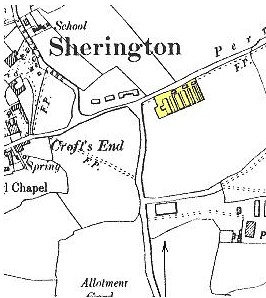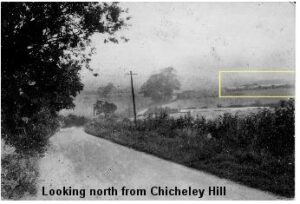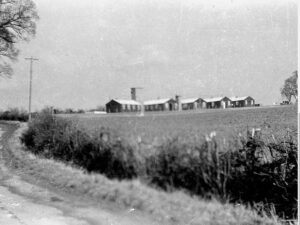 The Prisoner of War camp was situated at the top (east end) of what was then Calves End (and is now Crofts End). The area has been developed and the road is known as Hillview now. The POW camp was first noted in Newport Pagnell District Council notes, that it was to be built on Sherington land, in 1943. By the order of the Government, Newport Pagnell D.C. to locate the exact area. The land was then requisitioned from Yew Tree Farm, the Middleweek family were owners and farmed the land at this time. The camp was not an M.O.D. War dept. camp. It came under the control of WAR-AG, which was the Ministry responsible for agriculture, and consequently the 50 to 100 inmates of the camp worked mostly on the land for local farmers. This meant that these POWs were categorised as extremely low risk and were allowed a great deal of freedom to associate with the local villagers. It would also explain why a number of ex-POWs stayed on after their release in 1946-49. as they had made firm friends here.
The Prisoner of War camp was situated at the top (east end) of what was then Calves End (and is now Crofts End). The area has been developed and the road is known as Hillview now. The POW camp was first noted in Newport Pagnell District Council notes, that it was to be built on Sherington land, in 1943. By the order of the Government, Newport Pagnell D.C. to locate the exact area. The land was then requisitioned from Yew Tree Farm, the Middleweek family were owners and farmed the land at this time. The camp was not an M.O.D. War dept. camp. It came under the control of WAR-AG, which was the Ministry responsible for agriculture, and consequently the 50 to 100 inmates of the camp worked mostly on the land for local farmers. This meant that these POWs were categorised as extremely low risk and were allowed a great deal of freedom to associate with the local villagers. It would also explain why a number of ex-POWs stayed on after their release in 1946-49. as they had made firm friends here.
 One such ex-soldier, Fred Niebel, was captured at Caen a few days after D-Day. He came back to visit us in early 2004 and gave us an insight into the life of a POW in Sherington. He was a lorry driver and his duties were to deliver the men to various farms each morning and collect them at the end of the day. The POWs were paid a small wage for the work they did and were allowed freedom to attend the local cinema and village hall dances, etc. Not one of them ever absconded. At first these were all Italian men, but latterly, 1946 and after, it also housed German prisoners. ‘Prisoners’ is very loose term, as there was only one strand of wire around the camp perimeter. The camp also had its own monetary voucher system, so that the vouchers were stamped, much like the ration book system that the civilians were required to use, for items like toothpaste and soap. All their clothing was supplied, but with large round patches sewn on them, to make them easily distinguishable. The camp was under the supervision of Staff Sergeant Wilf Rollinson, who married Phyllis Middleweek. After Wilf was demobbed from the army he took charge of the camp as a WAR-AG executive.
One such ex-soldier, Fred Niebel, was captured at Caen a few days after D-Day. He came back to visit us in early 2004 and gave us an insight into the life of a POW in Sherington. He was a lorry driver and his duties were to deliver the men to various farms each morning and collect them at the end of the day. The POWs were paid a small wage for the work they did and were allowed freedom to attend the local cinema and village hall dances, etc. Not one of them ever absconded. At first these were all Italian men, but latterly, 1946 and after, it also housed German prisoners. ‘Prisoners’ is very loose term, as there was only one strand of wire around the camp perimeter. The camp also had its own monetary voucher system, so that the vouchers were stamped, much like the ration book system that the civilians were required to use, for items like toothpaste and soap. All their clothing was supplied, but with large round patches sewn on them, to make them easily distinguishable. The camp was under the supervision of Staff Sergeant Wilf Rollinson, who married Phyllis Middleweek. After Wilf was demobbed from the army he took charge of the camp as a WAR-AG executive.
There is also some anecdotal history of the relationship between the villagers and the prisoners. SHS has also built an archive file on the camp, this includes copies of some of the memorabilia that our visitor brought to us. We have some photos and names of the men who lived here during the years 1943-1949, we also have some copies of the letters that the POWs have written to their friends in Sherington after they returned to their homes in foreign countries. But we have yet to find out the Camp Number, we know that it came under the control of the Head Camp at Shalstone near Buckingham. That was known as Camp number 55 and that the inmates were discharged through camp 183, a transit camp. If anyone has more information on our Sherington POW camp we would appreciate receiving this, also any knowledge in general about how these WAR-AG camps were organised and run. Or where we could find out more information, this would be greatly appreciated.
Norman Arnold

